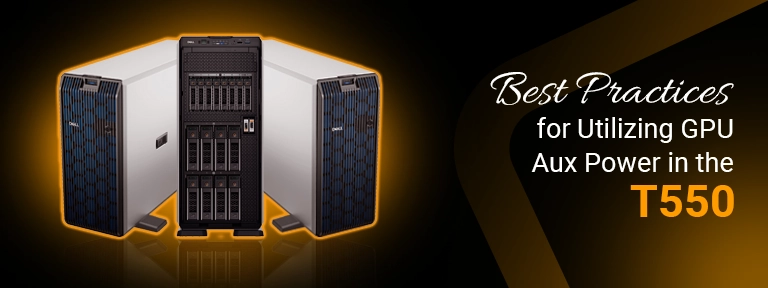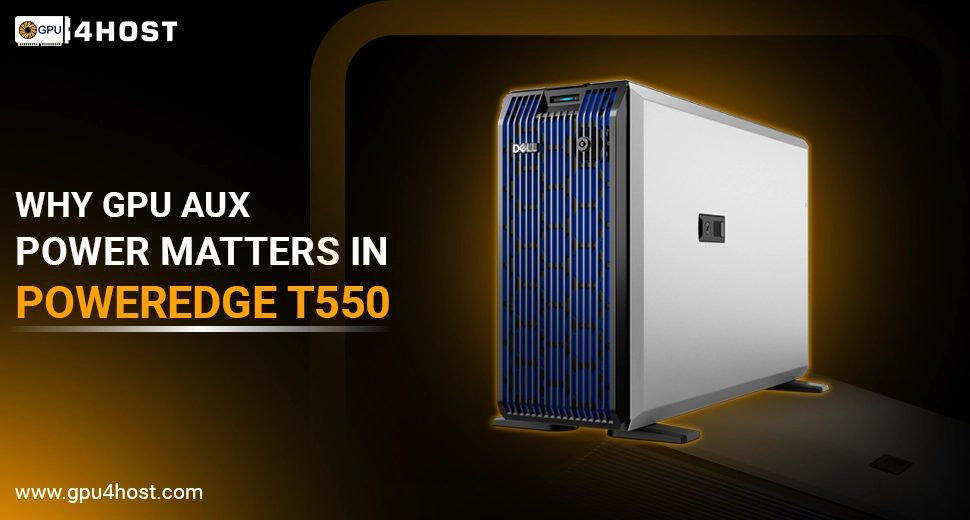A Guide About Why GPU Aux Power Matters in PowerEdge T550
At the time of setting up a GPU server for high-performance computing, AI-based tasks, or high-quality rendering workloads like all those from an AI image generator, knowing about the role of GPU Aux Power is very important. One of the most common enterprise-level workstations utilized in such scenarios is the Dell PowerEdge T550. This powerful tower server supports many AI GPUs, like the NVIDIA V100, and is perfect for small and medium GPU cluster deployments. But to make sure that your GPU dedicated server performs at its best, proper and stable GPU aux power connections are fixed.
In this whole guide, we’ll deeply dive into how GPU Aux power sockets work flawlessly in the PowerEdge T550, their setups, and best practices for configuring GPU hosting infrastructures utilizing this machine.
What Is GPU Aux Power?
GPU Aux Power basically refers to auxiliary power connections offered to a graphics card beyond what is supplied with the help of the PCIe slot. While a typical PCIe slot offers up to 75W, advanced AI GPUs generally need 150W, 300W, or a lot more, necessitating more power via 6-pin, 8-pin, or proprietary power connectors.
In the case of a GPU server, mainly ones set up for AI image generation, machine learning, or parallel computing, GPUs such as the NVIDIA V100 are power-hungry and need stable GPU Aux Power. If the power supply is inadequate or unstable, it may lead to system crashes, blocked performance, or even hardware damage.
Why GPU Aux Power Matters in PowerEdge T550
The PowerEdge T550 is a type of dual-socket tower server with a sufficient amount of support for a robust GPU cluster setup. It flawlessly supports multiple PCIe Gen4 GPUs and is improved for tasks like AI GPU computation, 3D rendering, etc.
Here is why GPU Aux Power is necessary in this setup:
Security & Compatibility
Utilizing the appropriate GPU Aux Power sockets guarantees proper security by avoiding overpower and excess heating.
Increasing Server Efficiency
Without adequate GPU Aux Power, GPUs will throttle, decreasing your GPU dedicated server’s productivity in various tasks such as inference, model training, or high-level rendering for AI image generator platforms.
Stable Process of High-Wattage GPUs
The NVIDIA A100, a go-to option in GPU hosting environments, needs a constant power supply to work properly. The PowerEdge T550 offers GPU Aux Power connectors to make sure that GPUs get the power they need.
GPU Aux Power Sockets in PowerEdge T550: A Complete Overview
The PowerEdge T550 supports many PCIe-based GPUs, with chosen Aux Power headers displayed on the system board or with the help of power cables connected directly from the power supply unit.
Socket Types & Power Ratings:
| Connector Type | Number of Pins | Power Output | Use |
| 6-pin PCIe | 6 | 75W | Entry GPUs |
| 8-pin PCIe | 8 | 150W | Mid-level GPUs |
| Dual 8-pin | 2 x 8 | 300W+ | High-level GPUs like NVIDIA A100 |
The T550 mainly consists of one or more 8-pin connectors through alternative GPU power cables. These connect simply to the server’s 1100W or 1600W redundant PSU, providing a sufficient amount of power for multi-GPU setups.
Where to Look for Aux Power Connectors:
- Inside the chassis, beside the GPU risers.
- At the power supply unit rail with routing for secure cable management.
- Some setups consist of included GPU power bridges or auxiliary boards.
Best Practices for Utilizing GPU Aux Power in the T550

Check Power Draw
Utilize Dell iDRAC or any other third-party tools to check GPU power utilization. This supports load balancing and prevents tripping the power rails.
Always Match the GPU Need to the PSU Output
Check the total power needed. A single NVIDIA A100 might simply draw up to 300 W of power. Multiply that by the number of GPUs to check if your PSU easily supports it or not.
Utilize Dell-Certified GPU Power Cables
Try not to utilize generic power cables in any situation. Dell-certified cables offer the right pinout and power delivery, decreasing the chances of damage.
Proper Cable Routing for Cooling Productivity
Complicated or obstructive cabling can show its impact on airflow. Make sure to utilize proper cable tutorials to maintain required cooling, mainly in high-load GPU Cluster cases.
General Issues: Because of Improper GPU Aux Power
- System Fails to Boot with GPU Installed
This generally takes place when the GPU aux power is not properly connected or is underpowered.
- Quick Thermal Shutdowns
An insufficient power supply can increase the load on the GPU, elevating thermal output and leading to automatic shutdowns.
- Error Codes or Red Lights on the Motherboard
Dell PowerEdge systems have typical LEDs to show faults in power. Inappropriate GPU Aux Power will generally be flagged.
How GPU4HOST Manages GPU Aux Power Just for You

At GPU4HOST, we utilize enterprise-level infrastructure along with a robust GPU server setup to offer the most trustworthy GPU hosting environment. Every single GPU server is set up with:
- A sufficient amount of power supply
- High-productivity cable management
- NVIDIA-based GPUs, consisting of the A100 and some other AI GPU models
This makes sure that if you’re deploying an AI image generator, simply training a complex model, or setting up a GPU Cluster, your GPU dedicated server gets constant, demanded power.
Final Thoughts
GPU Aux Power is not only a technical reconsideration—it’s a mission-centered aspect of any type of significant GPU server deployment. In some systems, such as the PowerEdge T550, correctly setting up GPU Aux Power guarantees proper stability, blazing-fast performance, and longevity of your GPUs, mainly at the time of utilizing robust features such as the NVIDIA A100 or V100.
For most of the businesses or developers running AI-based tasks, GPU hosting, or multi-GPU environments, well-known platforms such as GPU4HOST take the guesswork out of power planning by offering improved GPU dedicated server with trustworthy GPU Aux Power infrastructure.


